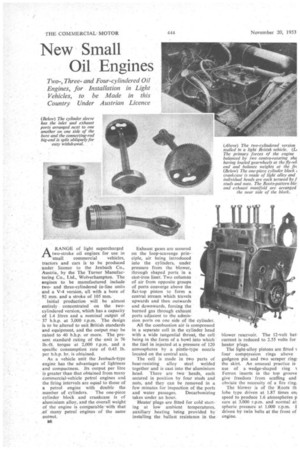New Small
Page 40

Page 41

If you've noticed an error in this article please click here to report it so we can fix it.
Oil Engines
Two-,Threeand Four-cylindered Oil Engines, for Installation in Light Vehicles, to be Made in this Country Under Austrian Licence
ARANGE of light supercharged two-stroke oil engines for use in
small commercial vehicles, tractors and cars is to be produced under licence to the Jenbach Co., Austria, by the The Turner Manufacturing Co., Ltd., Wolverhampton. The engines to be manufactured include twoand three-cylindered in-line units and a V-4 version, all with a bore of 92 mm. and a stroke of 105 mm.
Initial production will be almost entirely concentrated on the twocylindered version, which has a capacity of 1.4 litres and a nominal output of 37 b.h.p. at 3,000 r.p.m. The design is to be altered to suit British standards and equipment, and the output may be raised to 40 b.h.p. or more. The present standard rating of the unit is 76 lb.-ft. torque at 2,000 r.p.m. and a specific consumption rate of 0.45 lb. per b.h.p. hr. is obtained.
As a vehicle unit the Jenbach-type engine has the advantages of lightness and compactness. Its output per litre is greater than that obtained from many commercial-vehicle petrol engines and the firing intervals are equal to those of a petrol engine with double the
number of cylinders. The one-piece cylinder block and crankcase is of aluminium alloy, and the Overall weight of the engine is comparable' with that ,of. many petrol engines of the same outnut.
B6 Exhaust gases are scoured on the loop-scavenge principle, air being introduced into the cylinders, under pressure from the blower, through shaped ports in a cast-iron liner. Two columns of air from opposite groups of ports converge above the flat-top piston to form a central stream which travels upwards and then outwards and downwards, forcing the burned gas through exhaust ports adjacent to the admission ports on one side of the cylinder.
All the combustion air is compressed in a separate cell in the cylinder head with a wide tangential throat, the cell being in the form of a bowl into which' the fuel in injected at a pressure of 120 atmospheres by a pintle-type nozzle located on the central axis.
The cell is made in two parts of heat-resisting alloy steel welded together and is cast into the aluminium head. There are two heads, each secured in position by four studs and nuts, and they can be removed in a few minutes for inspection of the ports and water passages. Decarbonizing takes under an hour.
Heater plugs-are fitted for cold starting at low ambient temperatures, auxiliary heating being provided by installing the ballast resistance in the blower reservoir. The 12-volt ball current is reduced to 2.55 volts for heater plugs.
The light-alloy pistons are fitted t four compression rings above gudgeon pin and two scraper ring the skirt. An unusual practice is use of a wedge-shaped ring t Ferrox inserts in the top groove give freedom ' from scuffing and obviate the necessity of a fire ring.
The blower is of the Roots th lobe type driven at 1.87 times em speed to produce 1.6 atmospheres p sure at 3,000 r.p.m. and normal at spheric pressure at 1,000 r:p.m. I driven by twin belts at the front of engine. arge bearing surfaces are provided a hollow crankshaft, lead indium g used for the lower halves of the a bearings and the upper halves of connecting-rod bearings. The top es of the main bearings and the feeling rod caps are lined with a fetal bearing material.
il is circulated through a full-flow to the front journal, through the aw shaft to the main and big-end ings and from the latter to the sure-fed gudgeon pins. The oil p is of the gear type and two relief es are fitted in the system, one at pump outlet and the other between filter and the delivery line.
Protection for Beatings hen the lubricant viscosity is such the oil cannot be passed through ilter element it is returned direct to ;limp. This prevents dirt particles fling the bearings through the .nal filter by-pass,
se primary forces of the engine balanced by two contra-rotating one 'On each side of the cylinder k, having loaded gear wheels at the lee! end and balance weights at the t. The cooling water is circulated n impeller from an annular space he base of the cylinder through cal passages, cast in the linen to fylinder head. Special attention is to the avoidance of thermal ses and to the dissipation of heat the upper ring-belt area. An oil • of the stock pattern, can be I between the pump and cylinder cs.
1r vehicle applications, the existing tanical governor will be replaced the pneumatic type to improve sility. The injector pump is ated close to the cylinder heads ie side of the block to reduce the length. Other details of the engine de single-belt drive for the dynamo h has an extended shaft to drive water. impeller. The intake and ast silencers are the acoustic type.
Fitted in Land-Rover
e first commercial-vehicle applicais to a Land-Rover. A similar de may later be equipped with a -cylindercd unit, which should a performance comparable with of the existing petrol engine. For delivery vehicles, the low weight, actness and smooth running of the should enable conversions to be without major modifications to hassis, transmission or bodywork.
e two-cylindered engine weighs Lb. and it is 221 in. long, 19 in. and 28 in. high. The weight of three-cylindered unit is 450 lb, that of the V.4 is 540 lb.
e loop-scavenge principle for isting burned gases in the Jenbach le is likely to be used in other troke oil engines at present being oped, because efficient scavenging .ained without the use of valves. avoids the high valve-gear stresses ally associated with pressurenged two-stroke engines.




















































































